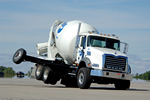A National Highway Traffic Safety Administration (NHTSA) rule requires electronic stability control (ESC) systems on trucks exceeding 26,000 lb. in gross weight, and is to be implemented in three phases beginning August 2017. Agency officials estimate it will prevent nearly 50 fatalities and more than 1,700 crashes and 600 injuries annually. They also credit ESC systems’ potential to curtail more than half of untripped, rollover crashes—those caused by striking an obstacle or leaving the road.
“ESC is a remarkable safety success story, a technology innovation that is already saving lives in passenger cars and light trucks,” said Transportation Secretary Anthony Foxx on announcing the rule. “Requiring ESC on heavy trucks will bring that innovation to the largest vehicles on our highways, increasing safety for drivers and passengers of these vehicles and for all road users.”
Reducing crashes through ESC in trucks and buses will save lives, move goods and people more efficiently, and reduce the toll crashes take on our economy through traffic delays and property damage, added NHTSA Administrator Mark Rosekind, contending, “It’s a win for the safety and convenience of the traveling public and for our economy.”
 ESC devices work instantly and automatically to maintain directional control in situations where the driver’s own steering and braking cannot be accomplished quickly enough to prevent a crash. Compliance with the NHTSA rule will be gauged with a “J-turn” test that replicates a curved highway off-ramp.
ESC devices work instantly and automatically to maintain directional control in situations where the driver’s own steering and braking cannot be accomplished quickly enough to prevent a crash. Compliance with the NHTSA rule will be gauged with a “J-turn” test that replicates a curved highway off-ramp.
The American Trucking Associations welcomes the announcement. “NHTSA reported to Congress that truck rollover and passenger ejection were the greatest threats to truck driver safety,” notes ATA Executive Vice President Dave Osiecki. “We can save lives by preventing rollovers with electronic stability control technology. Many fleets have already begun voluntarily utilizing this technology and this new requirement will only speed that process.”
STAKEHOLDER CONCURRENCE
Along with endorsing NHTSA’s action on full-stability technology for Class 7-8 trucks, Bendix Commercial Vehicle Systems assesses ESC performance against vehicle-stabilizing alternatives. “We believe ESC stands alone in terms of safety, performance, and value, and have seen a market acceptance of this technology—over [roll-only stability]—at a rate of three to one,” says Director of Government and Industry Affairs Fred Andersky. “This technology is another positive step on the part of our industry toward helping improve highway safety.”
From the perspective of Bendix, a market leader through its Electronic Stability Program (ESP) devices, Andersky notes that fleet operators currently equipping vehicles either with automatic brake only or roll-only stability systems need to understand three key differences in order to better prepare for the NHTSA rule:
- Full-stability solutions use more sensors than either automatic brake or roll-only stability components, creating a comprehensive system capable of addressing both roll and directional stability. Additional sensors enable the unit to more quickly recognize factors that could lead to vehicle rollovers or loss-of-control. On dry surfaces, the system recognizes and mitigates conditions that could lead to rollover and loss-of-control situations sooner than roll-only options. Full-stability technology also functions in a wider range of driving and road conditions than roll-only systems, including snowy, ice-covered, and slippery surfaces. Automatic braking systems are not designed to react to potential roll or loss-of-control situations.
- Interventions can differ. Full-stability systems rely on automatic brake interventions involving the steer, drive, and trailer axles, whereas roll-only devices typically apply only drive and trailer axle brakes. Slowing the vehicle quickly helps mitigate rollovers faster, while slowing and redirecting can help the driver maneuver in loss-of-control situations.
- Stability systems are the foundation for advanced active safety technologies. As a collision mitigation system detects a possible collision with a forward vehicle and automatically applies the brakes in order to prevent or lessen its severity, for example, the brake system should help the vehicle maintain its stability throughout the maneuver. This level of performance is best achieved with a full-stability system that is consistent with the new NHTSA rule.

“In our view, the market had already made its technology choice known prior to the formal introduction of NHTSA’s rule. Industry-wide, full stability is outselling roll-only technology three to one, up from three to two in previous years,” notes Andersky. “The increasing adoption of ESC demonstrates the willingness by fleets to invest in the technology because of full stability’s ability to help reduce the number of heavy truck accidents, improve safety records, and deliver the return on investment.”
“ESC helps save lives and reduce injuries and accident-related costs,” affirms Stephen Hanson, president of Meritor WABCO, which introduced its SmartTrac stability control system in 2003. SmartTrac customers’ experience entirely supports DOT Secretary Foxx’s view of ESC as a “remarkable success story,” he adds.
